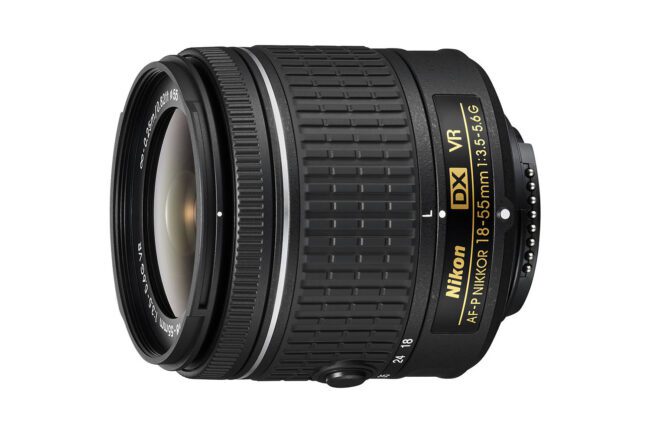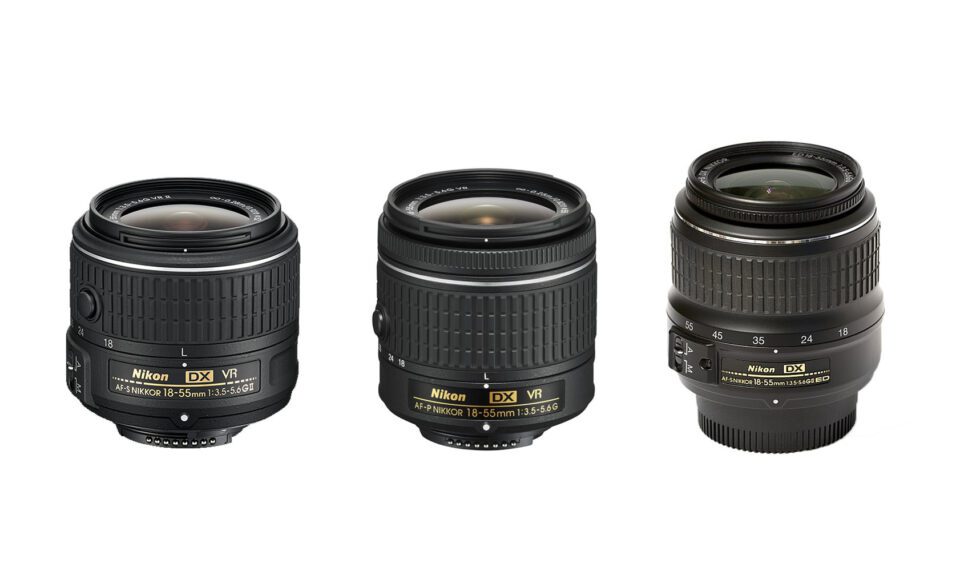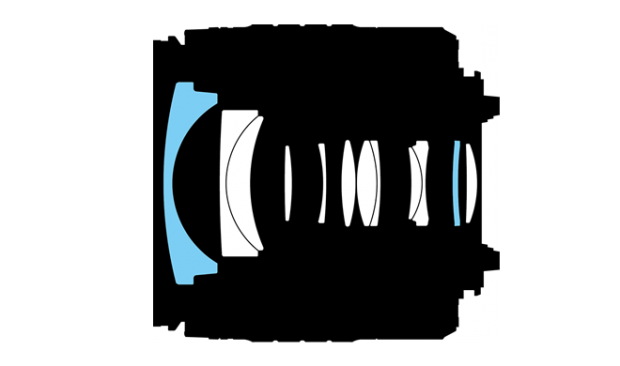Nikon Af-p Dx Nikkor 18-55mm F/35-56g Vr Review
In this in-depth field review, we are going to have a look at the Nikkor 18-55mm f/3.v-five.6G AF-P VR, the latest Nikon basic DX standard kit lens launched in September of 2016. Information technology is an all-plastic lens featuring the newest stepping motor, which focuses faster and quieter than the traditional silent moving ridge motor used on most standard Nikon lenses. The optical blueprint features two aspherical elements for better sharpness and chromatic aberration control.

The 18-55mm zooms are frequently delivered with entry-level Nikon DSLR bodies (such as D3400, D5600) as a bundle. They are also sold as standalone products and hence they are some of the most used lenses in the Nikon line-up. This is also the reason why the grey market place is flooded with different types of eighteen-55mm Nikkors. While the outset iterations of the lens (produced from 2005 until 2014) were known for average to poor quality, the newer AF-S VR Two generation released in 2014 gained much amend reputation due to solid optical performance in a lightweight body with efficient optical stabilization. In this review, I volition explore the performance characteristics of the latest eighteen-55mm AF-P VR version in item and compare it to both older iteration of eighteen-55mm AF-Southward VR Ii and other Nikon lenses, such as the Nikon eighteen-140mm VR.

Comparison to Older eighteen-55mm Lenses
In that location is a big mess in all the names and types of the modest and inexpensive 18-55mm Nikkor zooms that have been produced by Nikon since 2005. The orientation is hard, since at that place are in full 8 different versions of this lens (in five generations, the concluding 3 of which are either stabilized or non-stabilized). Nikon currently ships two different types of the 18-55mm zoom, either with or without optical stabilization. While "but" 4 different versions are sold at the fourth dimension being, you lot may however easily encounter older versions on grey marketplace. The first iii generations were notorious for poor build quality and low optical operation, then I do non recommend buying them at any price. If considering the eighteen-55mm focal range, I recommend buying either of the two concluding generations (depending on your DSLR body type – meet the compatibility chart below).
| Blazon | Released | Buy |
|---|---|---|
| AF-South DX Nikkor 18-55mm f/3.5-5.6G ED | 2006 | Not Recommended |
| AF-S DX Nikkor 18-55mm f/3.five-5.6G ED II | 2007 | Not Recommended |
| AF-S DX Nikkor 18-55mm f/3.5-5.6G VR | 2014 | Non Recommended |
| AF-Due south DX Nikkor 18-55mm f/3.5-5.6G VR Ii | 2014 | Recommended |
| AF-P DX Nikkor 18-55mm f/iii.5-five.6G VR | 2016 | Recommended |

In this review, I will focus on the comparison of the latest AF-P version with the older AF-S VR Ii version. Just for the sake of highlighting the progress of the concluding 2 generations, I also include the 2007 generation in the following comparing tabular array:
| Characteristic | AF-P 18-55mm VR | AF-S 18-55mm VR Ii | AF-S 18-55mm ED |
|---|---|---|---|
| Focal Length | 18-55mm | 18-55mm | 18-55mm |
| Maximum Discontinuity | f/3.5-five.6 | f/three.5-5.six | f/3.v-five.half dozen |
| Minimum Discontinuity | f/22-38 | f/22-36 | f/22 |
| Lens Elements | 12 | eleven | 11 |
| Lens Groups | nine | viii | 8 |
| Aspherical Elements | 2 | 1 | 1 |
| Angle of View | 76° – 28°50′ | 76° – 28°50′ | 76° – 28°l′ |
| Focus Motor | Pulsing (AF-P) | Silent Wave (AF-S) | Silent Wave (AF-S) |
| Minimum Focus Distance | 0.25m | 0.28m | 0.28m |
| Maximum Reproduction Ratio | 0.38x | 0.30x | 0.31x |
| Diaphragm Blades | seven (rounded) | 7 (rounded) | 7 (rounded) |
| Design | Collapsible | Collapsible | Standard |
| Sharpness | Adept Center, Solid Corners | Good Center, Average Corners | Average Center, Poor Corners |
| Chromatic Aberration | Well Controlled | Poorly Controlled | Poorly Controlled |
| Rotating Front Element | No | No | Yes |
| Instant Focus Override | Yes | No | No |
| Filter Size | 55mm | 52mm | 52mm |
| Size | 64.5mm x 62.5mm | 66mm x 59.5mm | 79mm x 73mm |
| Weight | 205g | 195g | 265g |
| Released | 2016 | 2014 | 2007 |
| VR Version Available | Yes | Aye | Yep |
| In Production | Yes | Aye | No |
| VR Version Price | $246 | $246 | $fifty-lxx |
And then how to discern those which I recommend from those that I would not (not even for total beginners)? Equally a rule of thumb, you can use the following rule: the latest two generations of 18-55mm lenses, that offering much better performance, have a button on the side of the lens barrel – this push is pushed to become the lens into the ready position.

Compatibility
Important notice: the AF-P line is only uniform with the latest Nikon DSLR bodies. It ways the number of cameras usable with the lens is limited.
Below is how Nikon Usa specifies this by grouping cameras in three subsets:
- Fully compatible models. Even for uniform cameras, firmware update may be required. Fully compatible models are: D7500, D5600, D5500, D5300, D3400, D3300, D500 and afterwards models
- Uniform models with express functions: D5, D810 serial, Df, D750, D7200, D7100, D5200, Nikon one series with the FT1
- Incompatible models: D4 series, D3 serial, D2 series, D1 series, D800 series, D700, D610, D600, D300 serial, D200, D100, D7000, D5100, D5000, D90, D80, D70 series, D3200, D3100, D3000, D60, D50, D40 serial, moving picture cameras
I have tested this lens on Nikon DSLR bodies D5300, D7100, Nikon 1 J5 (paired with FT-1 adapter) and D750 – all worked great, except that with D7100 and D750 I was non able to switch-off the VR function (see more beneath).
I take also tested this lens on my older Nikon DSLR D7000 and D90 (featured by Nikon as an incompatible model) and it indeed does not work. Since the focusing is fully electronic, you cannot even use the transmission focusing. The picture in the viewfinder stays blurred all the time, no thing how you plow the focus ring. Stay away from this lens if you have an old Nikon photographic camera body and you are planning to stick with information technology.
If you own a camera from the last grouping, I recommend choosing the older (2014) version of AF-S VR Two.

Lens Design, Handling and Features
The Nikon Nikkor 18-55mm AF-P is an all-plastic lens constructed to exist as small and lightweight as possible. It weighs just 205 grams (or 195g in case of the not-VR version)! While size and weight are some of the main advantages of the other DX AF-P lenses compared to their AF-Southward predecessors (in case of the 10-20mm wide-angle and the lxx-300mm telephoto zoom), there has been hardly improvement in this kit lens compared to the older iteration of the 18-55mm AF-S VR II, which already came with the collapsible design (button push) known from some Nikon 1 lenses.
The lens features a retracting mechanism. There is a small button on the outer butt, which needs to be pushed to become the lens into the shooting position. While pressing this push, you also have to rotate the zoom band, which unlocks the lens, gets information technology to the 18mm focal length mark and extends the total length of the lens by some 30mm. When retracting the lens, you have to do the aforementioned process, but in reverse. Dissimilar with the Nikon 1 system, the mere activation of the lens does not switch on the DSLR body. Hence y'all have to bear in heed that getting in the "shooting prepare" position takes a bit longer – yous have to switch on the camera and then switch on the lens. Some photographers mutter virtually that, just I am fine with one additional motility (takes near 2 seconds) as long every bit the lens offers solid optical functioning.
This footling lens features a limited range of eighteen-55mm (3.1x zoom ratio) equivalent to a 27-82.5mm zoom on a full-frame camera.

The front element moves when zooming (but does non rotate, which is important for round polarizing filter utilize). Similarly to the ten-20mm wide-angle version, the lens butt is shortest in the centre of the zoom range, at almost 30mm focal length marking. When zooming in or out from 30mm, information technology grows in length. The lens is virtually 62.5mm long in the meaty position and about 90mm long at the set up position (18mm focal distance). The maximum bore is 64.5mm.
Around the front end element, at that place is a thin manual focusing band, usable both in autofocus (AF) and manual focus (MF) modes. For switching those modes, yous must apply the DSLR internal card, every bit there is no mechanical push button/switch on the lens tube. This is identical for all DX AF-P lenses.
This lens allows you to override autofocus by only rotating the focus ring – whatsoever time, regardless of whether autofocus is on or off. I find this very handy and practical, especially when shooting close-ups (this lens has near-macro capabilities). The zoom ring is made of practiced safety, with 8mm, 24mm, 35mm, 45mm, and 55mm markings. Thanks to missing mechanical switches, the zoom ring is a bit larger compared to the previous version. At that place is not much of a movement needed to zoom from 18mm to 55mm (information technology needs almost 60° rotation).
The lens unsurprisingly features only a plastic barrel and mount. To me, this is no issue at all. Given the extending front chemical element, the plastic butt is non the most vulnerable part. I crashed my camera on a tripod with the 18-55mm VR II AF-S lens attached (previous generation lens, featuring almost identical blueprint), and the lens got damaged past distorting the front end element, not past breaking the barrel.
The optical organization consists of 12 lenses (ii aspherical), assembled in 9 groups, equally shown below:

The diaphragm is made of vii rounded blades. This lens comes without the HB-N106 bayonet hood – you have to purchase it extra, but I highly doubt ane really needs it (come across why under the ghosting and flare section on the next page).
Since it is a variable aperture lens, the focal length on it changes as you zoom in from f/three.5 to f/5.6 on the long end. The minimum discontinuity ranges from f/22 at 18mm to f/36 at 55mm. Hither is the complete overview of maximum apertures:
- 18mm – f/iii.5
- 20mm – f/3.8
- 24mm – f/four
- 28mm – f/4.2
- 32mm – f/iv.five
- 36mm – f/4.viii
- 40mm – f/5.0
- 46mm – f/5.three
- 52mm – f/5.6
Given the very express zoom ratio, it is quite a boring lens in terms of how much light it can gather, merely information technology is still a standard for kit lenses. This is by no means a weather-sealed lens. You should avoid shooting in heavy rain and in dusty conditions. On the other hand, I was shooting for two weeks in the Canary Islands and in Sultanate of oman (including in deserts) with information technology and I did not detect any dust / sand getting into the lens.
Autofocus Speed and Accuracy
The tertiary generation of the Nikkor xviii-55mm was the first-always lens in Nikon line-upwardly featuring the new AF-P engineering science. Compared to the previous generation of ultrasonic engines (Silent Wave Motor, or SWM, referred to as "AF-Southward"), the new stepping motor technology (abbreviation for auto-focus pulsing, referred to as the "AF-P") is faster and quieter. Quieter is actually not the right word – information technology is simply silent. The benefits are clear both for video shooting and for shooting stills. Focusing is very smooth, even in Live View Mode, where AF-S lenses tended to chase dorsum and along before nailing the focus. The new focus motor is so silent, that it is not audible in the soundtrack of the video (typically a problem in AF-S lenses).
Similar to my experience with the DX 70-300mm AF-P telephoto zoom, the real-life shooting experience shows that this lens focuses silently, accurately and reliably. I estimate that this lens focuses roughly xxx% faster than the older 18-55mm AF-S VR II lens. Focusing in depression-light with the D5300 was no trouble either.
Speed and muteness of the audio is non the only advantage. The AF-P version offers instant transmission override, which was non available on the previous 18-55mm AF-South version. It is a good feature to have in case y'all are shooting in difficult conditions and the lens is hunting. Yous can and so aid the lens to "find" the right range and make it snap into focus. Manual override has been featured in well-nigh of the recent Nikkor lenses – except for the cheapest 18-55mm kit lenses – information technology is praiseworthy that Nikon finally included this engineering into the cheapest lenses besides.
Nikkor 18-55mm allows for maximum magnification of 0.17x (1:1.26) at the closest focusing altitude of 0.25m (0.9 feet). Zoomed in to 55mm, this gives y'all a decent close-up photography (near macro magnification) possibilities. I tried to shoot insects on my lavender flower bed and I was quite happy with the ratio of in-focus shots. Photographing shy insects is not recommended with this lens, every bit 55mm is too brusque and yous have to be only a few centimeters abroad from your subject field which may affright information technology and arrive move abroad.

My but complaint concerns the missing AF ON / OFF switches (typically signed as Grand/A and M on Nikkor lenses). I repeat here what I wrote in the AF-P ten-20mm wide-bending review: even though 1 should praise Nikon for designing a faster and more quieter focusing lens, I realized that in combination with the missing on-the-lens switch, I experienced some frustrating moments. When shooting with the entry-level D5300 torso, I often had to opt for transmission focus (in camera trunk setting) while making some panoramas.
First of all, doing this in the camera bill of fare takes longer (do non underestimate how crucial this might be in some moments). What'south more, I repeatedly forgot to re-gear up the original setting (getting back to normal autofocus) and hence I concluded upwardly with a handful of out-of-focus shots. My error plainly, just I just want to highlight that information technology is easier to forget nearly this with AF-P lenses. Faster and noise-less focusing has also its drawbacks. I can easily lose the previous habit of controlling focus acquisition by the short just yet visible and audible refocusing process. The AF-P lenses are dissimilar in this attribute and you do not really notice when information technology actually acquired the right focus the mode it did with the older lenses. And so simply pay attention to other indicators (such as camera beep – which I hate, or blinking circular control in the viewfinder). Anyway, if I could, I wish I had the version with the AF-S / AF-M switch.
Source: https://photographylife.com/reviews/nikon-18-55mm-dx-vr-af-p
0 Response to "Nikon Af-p Dx Nikkor 18-55mm F/35-56g Vr Review"
Post a Comment